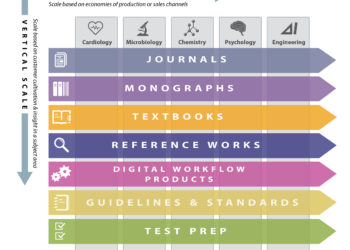Continuing our series of Kitchen Essential interviews with leaders of research infrastructure, today we hear from Phoebe McMellon, CEO of GeoScienceWorld. GeoScienceWorld is “the essential resource for and partner to the earth and planetary science community,” a nonprofit collaborative with a mission “to aggregate and disseminate information to advance earth science and to strengthen the sustainability of our society partners.”

Please tell us a bit about yourself – your role at GeoScienceWorld, how you got there, and why you embarked on a career in research infrastructure?
I am a geoscientist, a serial collector of skills, and I love collaborating and working with people. To say that I embarked on a career in research infrastructure would be stretching the truth. Like many in our industry, it was my expertise as a scientist, in particular geoscience, that brought me to this industry and led me to GeoScienceWorld, where I am the CEO.
GeoScienceWorld (GSW) is a small non-profit with a mission to support sustainable, independent society publishers and to support and advance geoscience research and researchers by aggregating and disseminating science. Being CEO of a small organization means that you wear a lot of hats and often find yourself not only building the strategy and leading the organization, but also on the front lines of execution. My journey to GSW involved a lot of detours, but in each role and industry that I worked in, I always gained a new perspective, skill or expertise that became a valuable asset later in my career.
Early in my career, I studied paleomagnetics and tectonics thinking I would end up in academia. I went to New Zealand on a Fulbright Scholarship to dive deeper into unraveling the tectonic history of the breakup of New Zealand, Antarctica, and Australia. However, I became less excited about pure research, and I became more inspired about applied research because I like seeing the immediate and real-world impact of my work. An example of this is my master’s thesis research, which I completed at the University of Canterbury in New Zealand and focused on understanding the availability and long-term sustainability of water resources in a region that wanted to transition from sheep farming to winemaking. At the time, there were only a handful of vineyards in the region, but the climate, soils, and terrain were all conducive to viticulture, and the land was inexpensive compared to other prime grape growing regions in New Zealand. My study and a subsequent study established that there was enough water available to sustain the development and it was incredibly gratifying (both personally and professionally) to go back many years later and see a valley where the water resources were supporting over 70 vineyards and 20+ wineries.
After an 8-year detour in New Zealand I moved back to New York and took some additional intended (and unintended) detours. But it was during the 2008 financial crisis when I was working for a landscape architecture firm that was on the verge of bankruptcy that an opportunity at Elsevier as Product Manager (with a geosciences background) presented itself. What I thought would be a year or two detour ended up being twelve and put me on an entirely new path and career.
Whilst my decision to embark on a career in research infrastructure was not intentional, I stayed because of the applied, real-world impact of the work we do, the continually intellectually stimulating challenges and opportunities, and the plethora of smart and collaborative people that I get to work and engage with, learn from, and serve.
What do you like most and least about working in research infrastructure?
The last paragraph sums up what I like most, specifically the real-world impact of supporting scientific discovery and advancing science. To quote Anne Roe, “Nothing in science has any value to society if it is not communicated,” and being part of the ecosystem that helps researchers communicate and disseminate their work is both personally and professionally gratifying.
What I like least is the lack of diversity, which exists on so many levels and in various parts of our industry, from equal representation in the C-suite and technology to the scientific communities we serve and within the academic research ecosystem. And it is acutely apparent within the Physical Sciences and related fields. Some sciences have improved relative to others, particularly with women’s representation, but we still have a long way to go in so many other areas. These biases and inequities are not introduced at the college and university level but start in primary and secondary schools where enrollment numbers of women and people of color drastically drop off between primary and secondary school, then again between secondary and tertiary education, and persist for these same groups at the graduate level with regard to research, mentoring, and funding opportunities and who gets published, hired, and promoted. As with many issues, there is no silver bullet and the issues that need to be solved are complex, deep rooted, and touch so many aspects of our society. To really make a difference and impact, it will require acknowledgement that there is an issue in the first place, significant long-term investment, and collaboration. I always need to remind myself that progress is not linear.
Based on your own experiences, what advice would you give someone starting, or thinking of starting, a career in research infrastructure?
I have two pieces of advice.
First, I will go back to my initial answer — Be a collector of skills. Take advantage of opportunities as they come, but don’t wait for them. If something interests you, find someone who does it well and learn from them. Don’t be afraid to ask lots of questions. The research infrastructure industry is complex – and requires a lot of different skills regardless of where you start or end up. Knowledge of the upstream value chain (e.g., publishing and content creation) will be valuable if you end up working downstream (e.g., discovery and distribution) and vice versa.
The second piece of advice is related to the first — Don’t be afraid to try something new and don’t let fear of failure get in the way. Most scientific progress and advancement is based on lots of failed experiments and mistakes. I wish our industry published more of that research; we could save amazing amounts of research dollars and accelerate the impact and the advancement of research if we did. I listen to a podcast called Moonshots & Mindsets, with Peter Diamandis, and in one podcast, Peter is interviewing his mentor, Dan Sullivan, about the entrepreneurial mindset and what makes someone a successful entrepreneur, and what they excitedly agree on is that in addition to having a high tolerance for risk and failure, successful entrepreneurs are obsessed with learning from their mistakes and failures (much more so than their successes) so they can learn and pivot quickly. In fact, when you get a bunch of entrepreneurs together at a conference, the plenaries, sessions, and conversations are all about their failures — not their successes. I love this and think this mindset is not only at the heart of the scientific method and scientific advancement, but also an important mindset to have as an individual, a member of society, and human on this planet.
So, try new things, learn from your mistakes, pivot, and do better next time.
What sort of infrastructure does GeoScienceWorld provide, and who are your users?
GSW is more than a provider of infrastructure and I say that because of our unique history and how we came to be. We were founded as a non-profit cooperative in 2004 by six leading geoscience society publishers and the American Geoscience Institute (AGI). The founders were inspired by BioOne, which launched in 2001, and modeled GSW after it. Our mission is to serve and sustain both small and large geoscience societies and the global geoscience research community.
The GSW platform, which is hosted on Silverchair, is an essential resource aggregating over 50 journals, 2,400 eBooks and 4.6 million abstracts indexed by GeoRef and serves more than 250,000 researchers working in academia, government, and a variety of geoscience-related industries.
The second group we serve is geoscience society publishers. We leverage economies of scale to provide a variety of services: hosting, renewals, editorial, and publishing services. The development of new services is a collaborative effort with our partners. For example, in 2018 we launched an open access community journal, Lithosphere, with six society publishers to provide a Gold open access option for their authors.
We are a small and nimble team that loves collaborating with our partners and end users to find new and better ways of supporting their needs.
How is GeoScienceWorld sustained financially?
GeoScienceWorld is sustained from a variety of programs and services: subscriptions to the GSW platform, which includes the journal aggregation and GeoRef, Society Services (hosting, membership access, renewals), eBook sales, and Lithsophere. A critical part of our mission is to deliver 90%+ of our earnings back to the societies and publishing partners in the form of royalties.
Since its inception, GSW has returned nearly $60 million back to our partners, which in turn helps support scholarships, grants, and educational programs; influences and informs policy, funding, and investment in the geosciences; and accelerates and advances our understanding of the earth and planetary sciences.
As the leader of a research infrastructure organization, what do you think are the biggest opportunities we’ve not yet realized as a community — and what’s stopping us?
Tackling and solving significant real-world problems. There are so many problems and phenomena that science and scientists are trying to better understand and solve: cancer, climate change, geological hazards, and poverty, just to name a few.
By leveraging scientific research with technological innovation, such as cloud computing and AI, we will be able to make huge strides in our understanding of complex processes and better predict events, diseases, and adverse outcomes before they happen — and ideally mitigate the problems and effects. But this will require trust, breaking down silos, and collaboration at scale.
What’s stopping us? Collaboration at scale is always a challenge as missions, visions, and goals are not always aligned. In addition, without the right incentives (and protections) in place for all parties, trust will always be an issue. So, I guess the real answer is human nature.
Looking at your own organization, what are you most proud of, and what keeps you awake at night?
I am most proud of the success of the collaborative and the speed at which we are able to deliver products and services. GSW has successfully delivered its mission and continues to do so. To date, we have delivered nearly $60M back to our partners and helped support advanced global geoscience research. We are coming up to our 20th anniversary and over the past year we have been interviewing our stakeholders for a video – the founders, society partners, researchers, librarians, and thought leaders – and I get emotional when so many in our community talk about the success and value of GSW: of how much GSW has given back and continues to give to the global geoscience community.
I joined GSW in November 2020 and therefore much credit for our success is due to the small yet smart, highly professional, and dedicated team that operates with incredible efficiency, effectiveness, and excellence. I am grateful each day that I get to work with this team!
What keeps me up at night? Making sure that we continue to deliver on both our mission and vision, which requires balancing the needs of our society partners with the needs of our researcher and librarian community, especially as technology and research output evolves and grows at exponential rates, but budgets do not.
What impact has/does/will AI have on GeoScienceWorld?
I see so many opportunities for us to leverage AI not only internally, but more significantly to partner with those who have the scale and capacity to develop the AI infrastructure and capabilities that we can take advantage of via an economy of scale model. We will likely have an interesting mix of solo initiatives that are specific for the geoscience domain and partnerships that develop more generic AI tools that we can leverage across the research infrastructure value chain (e.g., content curation, content generation, manuscript review and translation services, peer review, research integrity, research analyses and output, etc.).
The opportunities that I am most excited by are the ones where we can help researchers work more efficiently and advance our knowledge and understanding of the earth and planetary processes. The volume of publications and data available to researchers is astounding and it is impossible to read even a fraction of it all. AI will not only help synthesize large volumes of information, but also help identify correlations, find meaningful anomalies and outliers, and make serendipitous discoveries. It will help us visualize geological phenomena and processes in real time. It will help save lives.
Having said that, there are so many ways that we could and should be experimenting and leveraging AI to improve operational efficiency, to automate routine tasks, streamline administrative processes, and reduce costs so we can dedicate more time to meaningful projects and initiatives.
What changes do you think we’ll see in terms of the overall research infrastructure over the next five to ten years, and how will they impact the kinds of roles you’ll be hiring for at GeoScienceWorld?
As technology advances, it will put pressure on us to continue to evolve our value proposition and to deliver value back to our core communities. We will need to advance our technological capabilities and gain a deep understanding of our researchers’ and stakeholders’ needs, processes, and workflows.
To do the above, we will need to do three things:
- Hire people with data science/analytics expertise; as well as hire those with expertise in earth science, the domain we serve.
- Continue to invest in the professional development of GSW staff and advance our own internal knowledge and expertise.
- Undertake periodic governance reviews to evaluate both the board’s effectiveness and its diversity in social, professional, geographic, and perspective terms.
Collaboration and cooperation are in our DNA and the reality is that we will not be able to do this alone (nor should we). So even as we hire, invest, and grow our team, our efforts to deepen our relationships with existing partners, to build new partnerships with like-minded organizations, and to leverage the collective expertise from thought leaders within our community will all be critical for continuing to fulfill our mission and our future success.
It’s an exciting time to be at GSW and in research infrastructure!
Discussion
1 Thought on "Kitchen Essentials: An Interview with Phoebe McMellon of GeoScienceWorld"
So nice to hear about Phoebe’s success. Like before: very innovative, as well as loyal to the geoscience community. Best of luck, Phoebe.



